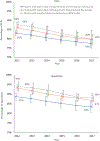Payment Discrepancies and Access to Primary Care Physicians for Dual-eligible Medicare-Medicaid Beneficiaries
- PMID: 33973937
- PMCID: PMC8486346
- DOI: 10.1097/MLR.0000000000001525
Payment Discrepancies and Access to Primary Care Physicians for Dual-eligible Medicare-Medicaid Beneficiaries
Abstract
Background: Physicians often receive lower payments for dual-eligible Medicare-Medicaid beneficiaries versus nondual Medicare beneficiaries because of state reimbursement caps. The Affordable Care Act (ACA) primary care fee bump temporarily eliminated this differential in 2013-2014.
Objective: To examine how dual payment policy impacts primary care physicians' (PCP) acceptance of duals.
Research design: We assessed differences in the likelihood that PCPs had dual caseloads of ≥10% or 20% in states with lower versus full dual reimbursement using linear probability models adjusted for physician and area-level traits. Using a triple-difference approach, we examined changes in dual caseloads for PCPs versus a control group of specialists in states with fee bumps versus no change during years postbump versus prebump.
Subjects: PCPs and specialists (cardiologists, orthopedic surgeons, general surgeons) that billed fee-for-service Medicare.
Measures: State dual payment policies and physicians' dual caseloads as a percentage of their Medicare patients.
Results: In 2012, 81% of PCPs had dual caseloads of ≥10% and this was less likely among PCPs in states with lower versus full dual reimbursement (eg, difference=-4.52 percentage points; 95% confidence interval, -6.80 to -2.25). The proportion of PCPs with dual caseloads of ≥10% or 20% decreased significantly between 2012 and 2017 and the fee bump was not consistently associated with increases in dual caseloads.
Conclusions: Pre-ACA, PCPs' participation in the dual program appeared to be lower in states with lower reimbursement for duals. Despite the ACA fee bump, dual caseloads declined over time, raising concerns of worsening access to care.
Copyright © 2021 Wolters Kluwer Health, Inc. All rights reserved.
Conflict of interest statement
J.P.N. discloses that he was a director of Aetna until May 2018, held Aetna stock until November 2018, and currently owns stock in Novartis and Medtronic. There are no other relevant disclosures. The remaining authors declare no conflict of interest.
Figures


Similar articles
-
Assessment of the Patient Protection and Affordable Care Act's Increase in Fees for Primary Care and Access to Care for Dual-Eligible Beneficiaries.JAMA Netw Open. 2021 Jan 4;4(1):e2033424. doi: 10.1001/jamanetworkopen.2020.33424. JAMA Netw Open. 2021. PMID: 33475756 Free PMC article.
-
Associations Between the Patient Protection and Affordable Care Act Medicaid Primary Care Payment Increase and Physician Participation in Medicaid.JAMA Intern Med. 2018 Aug 1;178(8):1042-1048. doi: 10.1001/jamainternmed.2018.2610. JAMA Intern Med. 2018. PMID: 30014133 Free PMC article.
-
Does Medicaid coverage of Medicare cost sharing affect physician care for dual-eligible Medicare beneficiaries?Health Serv Res. 2021 Jun;56(3):528-539. doi: 10.1111/1475-6773.13650. Epub 2021 Mar 28. Health Serv Res. 2021. PMID: 33778957 Free PMC article.
-
The Impact of Changes in Medicaid Provider Fees on Provider Participation and Enrollees' Care: a Systematic Literature Review.J Gen Intern Med. 2019 Oct;34(10):2200-2209. doi: 10.1007/s11606-019-05160-x. Epub 2019 Aug 6. J Gen Intern Med. 2019. PMID: 31388912 Free PMC article.
-
Reframing Medicare Physician Payment Policy for 2019: A Look at Proposed Policy.Pain Physician. 2018 Sep;21(5):415-432. Pain Physician. 2018. PMID: 30282387 Review.
Cited by
-
Better Nurse Practitioner Primary Care Practice Environments Reduce Hospitalization Disparities Among Dually-Enrolled Patients.Med Care. 2024 Apr 1;62(4):217-224. doi: 10.1097/MLR.0000000000001951. Epub 2023 Nov 24. Med Care. 2024. PMID: 38036459 Free PMC article.
-
State Variation in Medicare Reimbursement for the Top 100 Cardiothoracic Surgery Procedures, 2013-2022.Cureus. 2024 Sep 26;16(9):e70275. doi: 10.7759/cureus.70275. eCollection 2024 Sep. Cureus. 2024. PMID: 39463591 Free PMC article.
-
Changes in Medicare Reimbursement for Top Burn Surgery Procedures by State Between 2011 and 2022.Cureus. 2024 Sep 15;16(9):e69464. doi: 10.7759/cureus.69464. eCollection 2024 Sep. Cureus. 2024. PMID: 39411632 Free PMC article.
-
Evolving Economics: The Erosion of Medicare Reimbursement in Breast Surgery (2003-2023).Ann Surg Oncol. 2024 Oct;31(11):7303-7311. doi: 10.1245/s10434-024-15709-8. Epub 2024 Jul 20. Ann Surg Oncol. 2024. PMID: 39031257 Free PMC article.
-
The Impact of the Medicaid Reimbursement Bump on Influenza Vaccination Rates Among US Teens: Evidence from the National Immunization Survey-Teen 2011-2020.J Am Board Fam Med. 2024 Mar 11;37(1):137-146. doi: 10.3122/jabfm.2023.230170R2. J Am Board Fam Med. 2024. PMID: 38467428 Free PMC article.
References
-
- Congressional Budget Office. Dual-Eligible Beneficiaries of Medicare and Medicaid: Characteristics, Health Care Spending, and Evolving Policies. June2013. Available at: https://www.cbo.gov/sites/default/files/113th-congress-2013-2014/reports....AccessedJuly 19, 2020.
-
- Medicaid and CHIP Payment and Access Commission. Effects of Medicaid Coverage of Medicare Cost Sharing on Access to Care. March2015. Available at: https://www.macpac.gov/wp-content/uploads/2015/03/Effects-of-Medicaid-Co....AccessedJuly 19, 2020.
-
- Kaiser Familty Foundation. Medicaid-to-Medicare Fee Index. 2016. Available at: https://www.kff.org/medicaid/state-indicator/medicaid-to-medicare-fee-in....AccessedJuly 19, 2020.
-
- Berman S, Dolins J, Tang S-f, Yudkowsky B. Factors that influence the willingness of private primary care pediatricians to accept more Medicaid patients. Pediatrics 2002;110(2):239–248. - PubMed
-
- Zuckerman S, McFeeters J, Cunningham P, Nichols L. Changes in medicaid physician fees, 1998–2003: implications for physician participation. Health Aff (Millwood) 2004;23:W4–374 – W4–384. - PubMed
Publication types
MeSH terms
Grants and funding
LinkOut - more resources
Full Text Sources
Other Literature Sources
Medical
Miscellaneous

